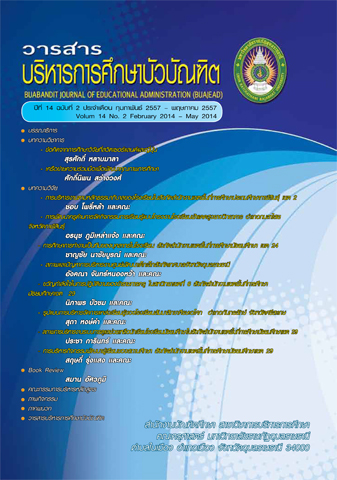รูปแบบการบริหารจัดการแหล่งเรียนรู้ของโรงเรียนสัมมาสิกขาศีรษะอโศก อำเภอกันทรลักษ์ จังหวัดศรีสะเกษ
Main Article Content
บทคัดย่อ
การวิจัยครั้งนี้มีวัตถุประสงค์เพื่อศึกษารูปแบบการบริหารจัดการแหล่งเรียนรู้ของโรงเรียนสัมมาสิกขาศีรษะอโศก อำเภอกันทรลักษ์ จังหวัดศรีสะเกษ 3 ด้าน คือ (1) การใช้แหล่งเรียนรู้ในการจัดการเรียนรู้กลุ่มสาระการเรียนรู้ (2) ลักษณะการใช้แหล่งเรียนรู้ด้านการวางแผน การใช้และการประเมินผล (3) จำนวนการใช้และปัญหาอุปสรรคในการใช้แหล่งเรียนรู้แต่ละประเภท
กลุ่มผู้ให้ข้อมูลได้แก่ ผู้บริหารและครูโรงเรียนสัมมาสิกขาศีรษะอโศก อำเภอกันทรลักษ์ จังหวัดศรีสะเกษ จำนวน 28 คน เครื่องมือที่ใช้ ในการเก็บรวบรวมข้อมูลคือ แบบสัมภาษณ์และ แบบสอบถามโดยใช้มาตราประมาณค่า 5 ระดับ จำนวน 34 ข้อ มีค่าความสอดคล้องของเครื่องมือ โดยผู้เชี่ยวชาญ (IOC) เท่ากับ 0.60-1.00 และมี ค่าความเชื่อมั่นของแบบสอบถาม .94 สถิติที่ใช้ ในการวิเคราะห์ข้อมูลเชิงปริมาณ ได้แก่ ค่าเฉลี่ย ร้อยละ และส่วนเบี่ยงเบนมาตรฐานและใช้การ วิเคราะห์เนื้อหาสำหรับข้อมูลเชิงคุณภาพ
ผลการวิจัยพบว่า
รูปแบบการบริหารจัดการแหล่งเรียนรู้ ของโรงเรียนสัมมาสิกขาศีรษะอโศก ดังนี้
1. การใช้แหล่งเรียนรู้ในการจัดการเรียนรู้ กลุ่มสาระการเรียนรู้ โดยรวมมีการใช้อยู่ในระดับมาก กลุ่มสาระการเรียนรู้ที่มีการใช้แหล่งเรียนรู้ มากที่สุด คือ กลุ่มสาระการเรียนรู้การงานอาชีพ และเทคโนโลยี รองลงมาคือ กลุ่มสาระการเรียนรู้ สังคม ศาสนา และวัฒนธรรม กลุ่มสาระการเรียนรู้ ที่มีการใช้แหล่งเรียนรู้น้อยคือ กลุ่มสาระการเรียนรู้ ศิลปะ
2. ลักษณะการใช้แหล่งเรียนรู้ ด้านการ วางแผนการใช้ และการประเมินผล โดยรวมมีการ ปฏิบัติอยู่ในระดับปานกลาง เมื่อพิจารณาเป็นรายข้อ พบว่า การให้นักเรียนเรียนรู้จากแหล่งเรียนรู้ โดยการลงมือปฏิบัติจริงมีระดับการปฏิบัติสูงสุด รองลงมาคือ การใช้แหล่งเรียนรู้เป็นวิถีชีวิตประจำวัน ของนักเรียน และการให้นักเรียนมีส่วนร่วมใน การพัฒนา อนุรักษ์และบำรุงรักษาแหล่งเรียนรู้ต่างๆ ตามความสามารถตาม ลำดับ ส่วนข้อที่มีระดับ การปฏิบัติต่ำสุดคือ การสรุปและรายงานผล เกี่ยวกับการดำเนินงานเป็นลายลักษณ์อักษร 3. จำนวนการใช้และปัญหาอุปสรรค ในการใช้แหล่งเรียนรู้แต่ละประเภท
3.1 แหล่งเรียนรู้ตามธรรมชาติที่มีผู้ใช้มากที่สุด คือ พลาญหิน รองลงมา คือ ป่าชุมชน ผู้ใช้น้อยที่สุด คือ น้ำตกภูลออ ปัญหาและอุปสรรค ของการใช้แหล่งเรียนรู้โดยรวม อยู่ในระดับน้อย ที่สุด
3.2 แหล่งเรียนรู้ที่สร้างขึ้นเพื่อการเรียนรู้ที่มีผู้ใช้มากทีสุ่ด คือ ห้องสมุด รองลงมา คือ ห้องคอมพิวเตอร์ และห้องสื่อสาระ ผู้ใช้น้อยที่สุด คือ ศาลาบรรพชน การใช้แหล่งเรียนรู้ประเภทนี้ โดยรวมไม่มีปัญหาและอุปสรรคของการใช้
3.3 แหล่งเรียนรู้ทางสังคมมีผู้ใช้มาก ที่สุด คือ สถานประกอบการ รองลงมา คือ วิถีชีวิตและวัฒนธรรม ผู้ใช้น้อยที่สุด คือ ประเพณีการใช้แหล่งเรียนรู้ประเภทนี้โดยรวมไม่มีปัญหาและ อุปสรรคของการใช้
3.4 แหล่งเรียนรู้ที่เป็นวิชาการอยู่ในตัวบุคคล มีผู้ใช้มากที่สุด คือ นักบวช รองลงมา คือ ครูภูมิปัญญา และวิทยากรพิเศษ ผู้ใช้น้อยที่สุด คือ ครูภูมิปัญญา การใช้แหล่งเรียนรู้ประเภทนี้โดยรวมไม่มีปัญหาและอุปสรรคของการใช้
The Learning Resource Management Model of Summasikkha Srisa Asoke School Kantaraluk Srisaket Province
The objective of this research is to study the learning resource management model of Summasikkha Srisa Asoke school, Kantaraluk, Srisaket, Thailand. (1) Management of subjects (2) Characteristics of planning, using and evaluating learning resources, (3) The amount of usability and the barrier of using the learning resources of each category.
The target group of the research is an administrator and 28 teachers of Summasikkha Srisa Asoke school. The method of data collection is an interview and questionnaire, using the 5 grades of valuation, 34 questions and statistics; the average, percentage and standard deviation were taken for analyzing the data.
The findings of the study were as follows :
The results of the research about the model of learning resource management of Summasikkha Srisa Asoke school are as follows;
1. Learning Resource management of subjects: The most important subjects for learning resource management are, firstly, vocation and technology, then society, religion and culture and, least importantly, art.
2. The characteristics of planning using and evaluating are generally performed in the middle level. When considered in detail, the highest average is to take students which are “learning by doing” from learning resources and the second highest is to give learning resources into student daily life and to make them participate in the development, preservation and maintenance of each resource. The lowest average is summarizing and report of evidence operation.
3. Amount of usability and the barrier of using the learning resources of each category:
3.1 Natural learning resources : The most users choose to work at Pa-lanhin (farm), then in the community forest and the least popular is Phu-la-oa water fall. The problem and barrier of using the learning resources is in lowest level.
3.2 Education learning resources: The most users chose the library then the computer and media room and the least popular is the museum hall (Bun-pa-chon hall). There were no problems or barriers in using learning resources.
3.3 Society learning resources: Users chose business way of life and culture and traditions respectively. Again there were no problems or barriers in using learning resources.
3.4 Individual learning resources: Users chose to learn with a monk, wise teacher (wisdom teacher) or special expert respectively. There were no problems or barriers in using learning resources.

